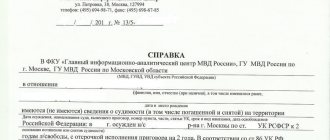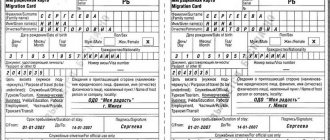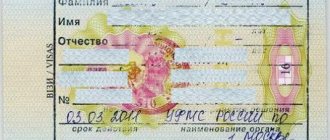To legally reside in Russia, a foreign citizen must obtain permits, such as a work permit, work patent, temporary residence permit, residence permit or passport of a citizen of the Russian Federation.
A prerequisite for obtaining any of these documents is the procedure of hand dactyloscopy - giving fingerprints.
Previously, this measure was not mandatory, but several years ago, after cases of foreigners attempting to enter Russia under a different name after deportation or violations of the law became more frequent, fingerprinting of foreign citizens was made a mandatory procedure.
In this article we will tell you what fingerprinting of migrants is, why fingerprint registration of foreign citizens is needed, as well as how and where to undergo fingerprinting.
Why is fingerprinting needed in Russia?
Fingerprinting in Russia is carried out not only for foreign citizens or criminals, but also for Russians themselves, for example, when applying for a biometric passport.
All information after fingerprinting is taken is stored in a database accessible to law enforcement agencies of the Russian Federation. Fingerprinting of migrants in Russia is not a new phenomenon. Back in 2012, this type of registration for migrants was introduced in St. Petersburg, then on a voluntary basis. Since 2013, the order of the Federal Migration Service has made it mandatory for foreign citizens to undergo fingerprinting to obtain documents, making fingerprint registration mandatory for obtaining temporary residence permits, residence permits, work permits and patents. And from October 12, 2021, foreign citizens must also undergo mandatory fingerprint registration when acquiring Russian citizenship.
At the same time, the examination of fingerprints of foreign citizens is not only a measure to increase security within the country, it can also become life-saving for the foreigner himself: for example, in the event of loss of any documents, a foreign citizen can be easily identified by fingerprints.
Fingerprinting at the RVP
After the documents have been collected and, together with an application from a foreign citizen, submitted to the Ministry of Internal Affairs, you need to wait for the decision of the migration authority.
This takes from two to 6 months. After receiving a positive answer, the migrant needs to undergo fingerprinting to obtain a temporary residence permit. Without a certificate of completion of the procedure, the migrant will not receive the desired document.
Important!
You can submit your fingerprints for a temporary residence permit on the same day when you submit your application for fingerprinting to the Ministry of Internal Affairs, if you have a passport and temporary registration.
The result and certificate of fingerprinting are issued an hour after the foreign citizen’s fingerprints are taken. The completed certificate contains the signature of the head of the department, registration number and seal. It is this document that is needed to obtain a temporary residence permit.
Application in practice using the example of the Russian Ministry of Defense
In the RF Armed Forces, DR for military and conscripts has been carried out since 2000. This procedure was established as mandatory to perpetuate the memory of defenders of the fatherland who died during service.
Fingerprinting is carried out in accordance with the provisions;
- Federal Law No. 128;
- RF PP N 386;
- Orders of the Minister of Defense of the Russian Federation N 205 and N 400;
Read also: Writing off tax debts
Corresponding Orders were also issued by other government agencies, whose employees must submit fingerprints:
- FSO;
- Ministry of Internal Affairs;
- FSB;
- Ministry of Emergency Situations;
- SVR;
- FCS;
- Ministry of Finance;
- Ministry of Justice;
- FMS, etc.
Annexes 1 and 2 of the said Orders contain the form of the registration card.
Decree of the Government of the Russian Federation of 04/06/1999 N 386 “On approval of the list of positions in which citizens of the Russian Federation serve, subject to mandatory state fingerprint registration”
Order of the Minister of Defense of the Russian Federation dated 04/02/2014 N 205 “On the organization of mandatory state fingerprint registration in the Armed Forces of the Russian Federation”
Order of the Minister of Defense of the Russian Federation dated October 2, 2007 N 400 “On measures to implement the Decree of the Government of the Russian Federation dated November 11, 2006 N 663”
Goals of OA GR
DR is used by the Ministry of Defense for:
- search for missing military personnel or already dismissed military personnel;
- confirmation of the employee's identity.
Location
The collection of fingerprints is carried out by territorial divisions of military registration and enlistment offices. Fingerprinting is carried out before the employee arrives at the place of duty.
Important! To undergo the procedure voluntarily, it is enough to visit the passport office at your place of residence or registration and submit the appropriate application. The collection of material is carried out in the territorial bodies of the Internal Affairs.
Categories of persons subject to fingerprinting
Fingerprints must be taken from:
- military, police, border guards, security guards and representatives of other professions whose activities pose a threat to life;
- civil servants;
- foreign citizens entering or already arriving in the country.
The RF Armed Forces carry out fingerprinting:
- conscripts;
- military;
- cadets studying in military educational organizations under the Ministry of Defense of the Russian Federation.
Material media
There are two methods for taking palm and fingerprints 2:
- paint (standard);
- paintless (electronic).
Standard method Electronic method
The received information is reflected and will be saved on the fingerprint card. In the second case, it will be downloaded to an electronic account card.
The card will contain:
- Full name, gender, date and place of birth and information on citizen registration;
- name of the authority that collected the data;
- reason and date of implementation of the DR.
Accounting
Control and storage of collected data is the responsibility of internal affairs bodies. There, file cabinets and logs of military personnel records are formed.
Place and terms of storage of fingerprint cards
The collected data is reflected in personal cards by specialists of local military commissars, after which they are transferred to the territorial information centers of the internal affairs bodies. There, media with information about conscripts and military personnel are stored until they reach the age of 80 or the death of the citizen.
On a note! The Ministry of Internal Affairs is responsible for the safety of information received from civilians. The information received is stored for no more than 10 years. Data on seafarers is kept in the port database until the citizen reaches 75 years of age.
What does a sample fingerprinting certificate look like?
Prospects
The RF Armed Forces are actively transitioning to an automated AR method. The use of scanners is justified because they reduce the time required to collect fingerprints and simplify data recording.
The generated electronic file cabinet allows you to search by the fingerprint of one finger or its fragment. Such a system is especially useful in determining the identity of unidentified corpses whose bodies have been so damaged that the necessary material may not be available.
Read also: Fisheries Law 2021
So, collecting fingerprints and palm prints is an important procedure necessary to establish the identity of civilians, military, foreigners and government employees. This task is carried out by specialized internal affairs bodies, carrying out collection on the basis of Federal Law No. 128.
How does fingerprinting work: the procedure for taking fingerprints of foreign citizens
A foreign citizen can undergo fingerprinting at the territorial department of the Ministry of Internal Affairs at the place of stay.
In essence, the process itself is a scanning of the foreign citizen’s fingerprints, namely the skin patterns on the pads of each finger. It is important that the foreigner's fingerprints are clear. On the fingerprint card, the fingerprints are placed so that each finger is located separately.
Before fingerprinting, migrants will be asked to wash their hands thoroughly. After which, an employee of the Ministry of Internal Affairs will roll each finger with a special roller with ink, and make a print of each finger and the palm itself on a special form. Fingerprinting is also done using special scanners; they read the skin pattern and save it in the database.
The result of fingerprinting is a fingerprinting certificate - a fingerprint card, which contains the following information:
- Gender and full name of the migrant
- Prints of each finger and individual palm
- Place and date of birth
- Signature of a foreign citizen
- Signature of the person who performed the procedure
- the date of the
- Why does a specific person need fingerprinting?
- Location of fingerprinting
Important!
Fingerprint registration of incapacitated persons, as well as minor children, must be carried out in the presence of their legal representatives, and fingerprinting of persons limited in legal capacity due to a mental disorder must be carried out in the presence of their guardians.
Please like if you found our article about where to get fingerprinting done for foreign citizens and why it is needed, or share information about how fingerprint registration of foreign citizens for a patent, temporary residence permit, residence permit and Russian passport is carried out on social networks :
General information
Fingerprinting is a method of identifying a person using his fingerprints and palm prints.
Accordingly, in order to subsequently determine the identity and record the collected information, the citizen must first go through the data collection procedure. This point is reflected in Art. 2 Federal Law No. 128. In order to fix all the conditions and procedures for conducting fingerprint registration of citizens at the federal level, Federal Law No. 128 was adopted. It established regulations for the voluntary and mandatory submission of data.
Each government agency whose employees must submit fingerprints has separate laws. For example, for representatives of the Ministry of Emergency Situations - Federal Law No. 151 and Order of the Ministry of Emergency Situations No. 366, for employees of the FSB - Federal Law No. 40 and Order of the FSB No. 719. for defenders of the fatherland, workers or conscripts into the ranks of the RF Armed Forces - Federal Law No. 53, for employees of the Ministry of Internal Affairs - Federal Law N 27 and Order of the Ministry of Internal Affairs N 769, for private detectives and security guards - Federal Law N 272, for police officers - Law N 1026-1.
Description of the law
Federal Law No. 128 consists of five chapters.
| Chapter | What I secured |
| 1 | General provisions |
| 2 | Procedure and methods for conducting fingerprint state registration |
| 3 | Regulations for storage, use and destruction of information |
| 4 | Algorithm for supervision and control of compliance with the provisions of the Federal Law |
| 5 | Conclusion |
Federal Law No. 128 approved:
- basic terms related to fingerprint registration;
- purposes of fingerprinting;
- legal basis of the document and its compliance;
- list of persons from whom personal data is required to be collected.
At the end of the document, the conditions for financing activities for fingerprint state registration are fixed.
What it regulates and why
The main goal of the document is to establish uniform requirements for conducting PD of foreigners and Russian citizens, and to regulate the algorithm for storing and using the collected data.
Important! The law established that fingerprinting can be carried out voluntarily or compulsorily. Each procedure is carried out according to different conditions.
Monitoring compliance with the legal provisions on fingerprinting is carried out at the following levels:
- prosecutor's office;
- departmental;
- judicial
The collected data (according to Article 6) can be used for:
- search for missing foreigners, stateless persons or Russians who were inside the Russian Federation;
- establishing the identity of citizens who are unable to confirm it independently;
- crime investigations.
Read also: Tax on winnings in Russia
Therefore, you have the right to access such data;
- courts;
- employees from the prosecutor's office;
- authorities dealing with cases of administrative violations;
- bodies carrying out preliminary investigation, inquiry or search.
If we are talking about foreign citizens, then in order to obtain additional information necessary to establish the identity of a person, you need to obtain approval from foreign government agencies and organizations. Interaction between domestic and foreign authorities is carried out in accordance with the provisions of international treaties.
Reason for performing fingerprinting
The reason for sending a citizen to undergo DR may be:
- decision of the draft commission;
- order of appointment to a position in the Ministry of Internal Affairs or the Armed Forces;
- appeal from the head of a government agency;
- an application for voluntary fingerprinting submitted by a citizen or his guardians;
- a decision to initiate proceedings against a person whose identity needs to be established through the collection of fingerprints.










